Assessment of Ecological Distribution, Species Diversity, Utilization and Conservation of Indigenous Medicinal Plants in Kilifi North, Kilifi County –Kenya
Article Information
Rita Kanini Mulatya1*, Benards Okeyo1, Najma Dharani2
1Department of Environmental Science, Pwani University, Kilifi, Kenya
2Department of Plant Sciences, Kenyatta University, Nairobi, Kenya
*Corresponding Author: Rita Kanini Mulatya, Department of Environmental Sciences, Pwani University, Kilifi, Kenya
Received: 02 October 2023; Accepted: 26 October 2023; Published: 07 November 2023
Citation: Rita Kanini Mulatya, Benards Okeyo, Najma Dharani. Assessment of Ecological Distribution, Species Diversity, Utilization and Conservation of Indigenous Medicinal Plants in Kilifi North, Kilifi County –Kenya. International Journal of Plant, Animal and Environmental Sciences. 13 (2023): 91-105.
View / Download Pdf Share at FacebookAbstract
In Jilore, Magarini, and Matsangoni of Kilifi County, assessments of ecological species variety, distribution, abundance, and utilization of therapeutic flora were made. Total of 90 field survey forms were distributed randomly to 90 households. Additionally, 60 10m × 10m quadrats were set up along 6 transects to gather data on the vegetation.
From the study, 97 floral species were identified. Menhinick, Dominance, Shannon-weinner, and Margalef indices were 1.8, 0.93, 3.3 and 9.8 respectively. Sorensen’s similarity and Jaccard indices were 0.12 and 0.045 respectively. Abundance class 1 and 8-16 had the most species of 17 and 14 respectively, while class 128-256 and 256-512 had the least individual species. The findings showed that 51% of all respondents collected therapeutic flora as their prime health care to date.
There was a positive correlation with a p-value of 0.05 between utilization of medicinal plants and gender, level of education and income per capita with 0.349, 0.164 and 0.105 respectively. Conservation and domestication of medicinal plants was embraced by 40% of the respondents. There’s need for determination of the efficacy and pharmacological profiles of these curative plants in future since not everyone in the community was familiar with the species.
Keywords
Kilifi county; Therapeutic flora; Utilization; Abundance; Conservation; Diversity; Distribution
Kilifi county articles; Therapeutic flora articles; Utilization articles; Abundance articles; Conservation articles; Diversity articles; Distribution articles
Article Details
1. Introduction
A population of more than 22.9% of the entire globe’s populace depends on forest resources for their living [1]. FAO [2] projected that approximately 2 billion of the populace of the globe utilize trees on farms and on community forests to generate food, medicine, shelter, fuel, and cash. A population of 2.7 billion people lives in the rural areas and reports indicate that over 75% of them rely on therapeutic plants as their principal healthcare [3].
Since ancient times, plants have been used for their medicinal value by human beings and out of 258,650 species of upper plants reported globally, 10% are habituated to cure ailing communities [4]. World Health Organization [5] estimates that over 3.5 billion of the 85% Sphere's populace residing in the developing world depends upon plants as components of their core healthcare. Jamann et al. [6] estimates that 6.05 billion people occupying Asian and African countries and over 50% of the population in North America, Europe and other industrialized countries rely upon medicinal plants for healthcare a minimum of once in a very year.
Prior to the arrival of Western linctus, Africans had created their own successful techniques of remedying ailments, whether they had spiritual or physical causes [7]. Even while the consumption of western linctus has accelerated in Africa [8,9] indigenous African medicines and cures have not been abandoned. It has been reported that the wide use of therapeutic flora in Africa can be attributed to the following factors: the accessibility of traditional healthcare providers in relation to modern western healthcare; generated cash; the price of modern-day medications; academic level; gender; age; and religious beliefs [10].
Kenya doesn't seem to be an exception when it comes to how people utilize forests [11]. Kenya accommodates assorted forest types, including montane, rainforest, savanna, shrub, and mangrove [12]. Over 7,000 florae have been recorded in Kenya, with several useful therapeutic plants among them [13]. Over 90% of the Kenyan populace consumes therapeutic florae at some time in their lives, and over 37.64 million Kenyans depend on therapeutic florae as their primary source of homoeopathic care [14]. Tsigemelak et al. [14], Kigen et al. [15] and Dharani [9] all point to a lack of suitable modern health facilities as a cause of the reliance on therapeutic plants.
There were severe environmental losses from the 1990s timber harvest of up to 93,000 hectares (ha) [16]. Approximately 186,000 hectares (ha) of Kenya's remaining forest cover was lost between 1990 and 2005, with 38,000 hectares (ha) of it being indigenous forests [17]. Medicinal plant populations have been shown to be declining in recent years [18]. Most medicinal plants are lost as a result of grazing, clear-felling for agricultural operations, indiscriminate harvesting, overexploitation, and clearing for settlements, as stated by Omwenga et al. [19]. Some medicinal plant species are becoming scarcer due to unsustainable harvesting practices [20,21].
Because of differences in geographical location and climate complexity, stopping the loss of biodiversity is challenging for medicinal plants [22]. In addition, the challenges faced by medicinal species vary with their demand, geographic location, and proximity to other hazards [20,21]. Several factors, such as the components removed, the species' obtainability, and the need, are considered in order to stipulate which species should be given protection urgency [23]. Numerous studies have been done to assess the conservation measures used to protect medicinal plants in Kenya; however, few records exist due to the widespread belief, held by many participants, that therapeutic plants grow naturally and are never in need of care [24].
In Kenya, ethnobotany has received a lot of attention, although studies in Kilifi County have been few. To ensure these species' survival, vital tree types, reports must detail the accessibility of therapeutic florae and provide a response to the query about the status of the variety of curative flora. There is also a need for abrupt documenting to prevent these floras from extinction. For future usage conservation of such trees, it is also necessary to conduct constant monitoring, identification, and documentation of medicinal plants before they are lost forever. Natural resource documentation particularly that of medicinal plants is also important since it aids in the preservation of ecologically significant areas.
2. Materials and Methods
2.1 Study area
Three locations (Magarini, Jilore, and Matsangoni) in Kilifi County served as the study areas. The county is located between longitude 39o05 and 40o14 East and latitude 2o20 and 4o South. There are 1,453,787 people living in Kilifi County overall [25] (Figure 1a). Regarding the study areas, Jilore has 12,311 residents, Matsangoni has 18,806 people, and Magarini (Dakatcha) has 6558 people [25]. The Giriama ethnic group is the most prevalent one among the three places (Figure 1b).
3. Sampling Procedure
3.1 Selection of respondents
Ninety households were randomly selected from the three study locations and given a detailed questionnaire designed to elicit qualitative responses. The names, methods of prescription, parts used, accessibility, techniques of exploitation, and protection mechanisms in place for commonly used therapeutic plants to manage human and animal pathological illnesses and other purposes were noted.
3.2 Vegetation sampling
The therapeutic plant species diversity, abundance, richness, evenness, and other quantitative data were recorded using the Transect and Quadrat methods at the study site. Within each 600-meter transect set up at each study site, 10*10-meter quadrats were put out at 50-meter intervals using GPS technology [26]. Each sample plot was surveyed thoroughly, and all the flora was recorded. Trees were defined as individuals with a girth/dbh of ≥30cm, saplings as those 5 – 29cm in girth, while seedlings were those that were ≤ 1 meter in height.
3.3 Data analysis
Data was imported into JASP version 0.17.2.1, where summaries of data sets (Mean, median, variance and standard deviation), regression and Pearson Correlation were applied to draw connections among medicinal application while paying attention to demographic characteristics like education level, gender, income per capita, main financial activity, and age. The degree of correlation between independent variables, as well as the relationship between consumption, harvesting, threats, and conservation of the researched therapeutic flora, were determined via the use of multiple regression and Pearson correlation.
Pearson r correlation is the most widely used correlation statistic to measure the degree of the relationship between linearly related variables. The following formula is used to calculate the Pearson r correlation:

rxy = Pearson r correlation coefficient between x and y
n = number of observations
xi = value of x (for ith observation)
yi = value of y (for ith observation)
NCSS and Biodiversity index Calculator were used to collect and evaluate species richness, abundance, species diversity and dominance index.
3.4 Species diversity
The number of different therapeutic species present in the three study sites was determined. Using the Shannon-wiener diversity index(H), the species diversity of the three research areas was calculated.
H=−∑[(pi)×ln(pi)]
Where:
∑=Sum
pi=proportion of individuals of i-th species in a whole community
ln=Natural logarithm
3.5 Species richness
The variety of existence at each of the three locations was measured with the use of the Margalef index. The Margalef index was established in 1958 as a way to quantify the prevalence of species [27]
Margalef’s index = (S – 1) / In N
S = sum of the species present in the ecosystems
N = Sum of individuals in the sample
In = natural logarithm
3.6 Species evenness and similarity index
To report on species evenness, the first order Jackknife estimations and pileous Evenness (E) of the analyzed locations were computed. A species cumulative curve was also built for the three research locations. Sorensen’s coefficient (SC) is a measure of similarity between flora groups. Sorensen’s coefficient was computed to compare the therapeutic plants composition and their similarity among the three sites. Menhinick and dominance indices were determined using the following formulae.
Menhinick index (I) = S/√N
Where: I= Menhinick index
S= Specific species number
N= Total number of individuals
Dominance index (d)= Nmax/N
Where: d= Dominance index
Nmax= Sum of the most abundant species
N= Total number of individuals
4. Results
4.1 Abundance and frequency of therapeutic flora in Magarini, Matsangoni and Jilore
From the three locations, 97 plant species formed the basis of the research. Eighty-nine percent of the plants found were considered to have therapeutic properties. There were a total of 268 Croton dichogamus, 214 Manilkara sulcata and 104 Flueggea virosa among the three study locations. Manilkara sulcata had the highest relative frequency (66.67 percent), followed by Croton dichogamus (50 percent) and Psydrax mombasae (50%). The relative frequency was 33.33% for Flueggea virosa, Cynometra webberi, and Thespasia danis as shown in the Figure 2 below. In addition, abundance class 1 and 8-16 had the most species amounting to 17 and 14 respectively. Classes 128 – 256 and 256 – 512 had the least species individuals.
4.2 Species Richness, diversity, and dominance in Matsangoni, Magarini and Jilore sites
Menhinick index is used to measure how assorted species are in a population. Menhinick index was employed in this study to check abundance while Margalef index, dominance index and the Shannon-Wiener diversity index (H') were employed to quantify species richness, dominance, and diversity respectively. The Margalef index was at 9.8 meaning that there was a relatively high species richness as well as high dominance (0.93) of species in the three study sites. In addition, the diversity of the three study sites was very high with a measure of 3.3 and moderately high Menhinick index of 1.8. See Table 1 Dominance index Margalef richness index and Shannon index.
Table 1: Menhinick, margalef, dominance, Shannon-wiener indices of the study sites.
A comparison on diversity, richness, dominance and abundance on the three sites was made. Matsangoni had the highest diversity, dominance, menhinick and margalef indices (Table 2).
Table 2: Dominance, shannon-weiner, menhinick and margaef indices of Matsangoni, Magarini and Jilore.
4.3 Sorensen’s similarity and Jaccard indices
From the results, there were 4 common species in the 3 areas of focus. Strychnos madagascarensis, Balanites wilsoniana, Cordia sinensis and Clausena anisata were common in the study sites. Sorensen’s index values range between 0 and 1. Value 0 means that the communities have exactly the same species composition while 1 means that they don’t share any species. The areas of focus had a Sorensen’s similarity index of 0.12 meaning that the 3 study sites are slightly shared species. Jaccard index which also measures the similarity of samples was found to be 0.045. The closer the index is to 1 the higher the similarity between or among the sample sets (Table 3).
|
Absolute beta Value ((S0-c)-(S1-c)...): |
88 |
Whittaker's Index (S/alpha): |
3 |
|
Sørensen's similarity index: |
0.12 |
Alternate Whittaker's Index (S/alpha-1): |
2 |
|
Sørensen's similarity index (%): |
12% |
Jaccard Index: |
0.045 |
|
Routledge beta-R Index: |
90 |
Jaccard Index (%): |
4.5% |
|
Mountford Index: |
0.00012 |
Number of Common Species: |
4 |
|
Mountford Index (%): |
0.012% |
Bray Curtis dissimilarity |
0.88 |
Table 3: Sorensen's and Jaccard indices.
4.4 Utilization of therapeutic flora
Azadirachta indica, a non-native species, was the most frequently used pharmaceutical plant in Jilore, Magarini, and Matsangoni (64.44%). Besides it, Oldifiedia somalensis, Aloe kilifiensis, Grewia plagiophylla, Croton dichogamus, and Moringa oloifera were the most used indigenous species by the responders with frequencies of 54.44%, 26.67%, 24.44%, 23.33% and 23.33% respectively. In addition to being the least well-known, Clausena anisata, Dichrostachys cineras, Manilkara mochisa, Bombax rhodognophalon, Mundulea sericea, Premna resinosa, Piliostigma thonningii, Dobera glabra, Senna alata, Harrisonia abyssinica, Annona senegalensis and Senna siamea (1.11%) were the least used species in focal areas (Figure 4).
Fever (18.5%), gastroenteritis (14%), anginas (7.3%), bruise (6.0%), hacks (4.8%), snake bites (4.8%), gastroenteritis (4.2%), grippe (3.8%), and oedema (3.8%) were the most commonly managed pathological conditions in the study areas. The least common homeopathic uses of therapeutic flora in the areas of focus were water treatment, control of jiggers, remedy of appendix, ears, STDs, constipation, and cardiac associated diseases (Figure 5). Utilization of curative flora was examined in relation to age, gender, education level, per capita income, household size, and primary economic activity.
4.5 Age of participant and extracting of therapeutic florae
The participant's age was hypothesized to be a factor in the use of medicinal herbs. According to Silva et al. [28] older persons may have more expertise using therapeutic vegetation because of their extensive knowledge and regular exposure to them. According to Begossi et al. [29], it was predicted that younger people would use medicinal herbs less frequently than older people (Table 4). According to the results of this survey, 11.1% of participants aged under 35 were reported to be utilizing therapeutic vegetation as their main source of healthcare. The utilization was highest among the people of age group 41- 45 years.
|
Age |
Cumulative % |
|
41-45 years |
0.1889 |
|
51-55 years |
0.1778 |
|
Above 61 years |
0.1667 |
|
36-40 years |
0.1556 |
|
56-60 years |
0.1 |
|
31-35 years |
0.1 |
|
46-50 years |
0.1 |
|
26-30 years |
0.0111 |
|
Grand Total |
1 |
Table 4: Age and utilization of medicinal plants in the study areas.
4.6 Utilization of therapeutic flora vs. gender
According to current assessments of Razafindraibe et al. [30] and Qureshi and Ghufran [31], women make up the majority of those who utilize therapeutic flora. See the table (Table 5 and Figure 6). Unfortunately, in this study, men participants used therapeutic vegetation more frequently than the equivalent females. It was clear that 42% of participants who used pharmaceutical flora were female and 58% of participants were men.
|
% of utilization |
|
|
Gender |
Count of Gender |
|
Male |
0.5778 |
|
female |
0.4222 |
|
Grand Total |
1 |
Table 5: Utilization of medicinal plants vs. gender in Matsangoni, Magarini and Jilore.
4.7 Consumption of medicinal plants vs. level of education
Individuals with insignificant basic schooling were hypothesized to have more familiarity with therapeutic plants and higher rates of therapeutic plant consumption [32]. This is due to the local structure and the reality that those who have completed formal education have more options in life than those who have not [33]. Modern medical treatments are more affordable for the village's educated residents, while the less-informed choose for less-expensive remedies made from plants [34].
Of the participants who reported using therapeutic flora throughout the three research sites, 59% either had no proper schooling or had only completed elementary school, while 41% had finished secondary or higher schooling (Figure 7).
4.8 Income per capita and prime financial engendering activity
Income per capita is used to describe the quantity of cash engendered by an individual, family, nation or continent. The standard measure of a country's prosperity is its per capita income. Previous research has suggested that households with limited means will rely largely on therapeutic vegetation due to their convenience and low cost. As a result, it was considered that people living in areas with a lower per capita income were more likely to make use of therapeutic vegetation. Daily average income was converted to Kenyan shillings (Kshs). Eighty-two percent and seventy-six percent of those who answered the survey and reported using therapeutic herbs, respectively, had a per capita income of Kshs. 0 to 100 and Kshs. 101 to 500. Figure 8 shows participants with a per capita daily income of between Kshs. 501 and Kshs. 1000 were least likely to rely on traditional medicines.
Person correlation between consumption of therapeutic flora to independent size of the family, age, main financial engendering activity, gender, daily generated cash and education level.
The degree of relationship between linearly related variables was determined. The statistical significance relationship of utilization and dependent variables such as age, gender, income per capita, education level, household size and primary economic activity was calculated. The R2 of the model was 0.041for the H1 meaning that variability was explained (Table 6).
|
Utilization of Medicinal Plants |
||||
|
Model |
R |
R² |
Adjusted R² |
RMSE |
|
H0 |
0 |
0 |
0 |
0.503 |
|
H1 |
0.203 |
0.041 |
-0.028 |
0.51 |
Table 6: Model summary of utilization of therapeutic plants.
4.9 Person correlation between utilization and demographic factors
The z-score which is used to determine dispersion of data was between -1.273 and 1.039 meaning that the datum lied closer to the mean. The data was then tested at p-value > 0.05 significance level. Use of remedial flora was positively related to all independent variables as follows; gender (0.349), participant level of education (0.164), and primary economic activity (0.105) with p> 0.05. As can be shown in (Table 7) below, there was a negative connection between therapeutic florae use and several demographic variables, including participant age (-0.144), income per capita (-0.266), and household size (-0.061).
|
Variable |
Sample size |
Person’s r |
z-score |
p |
Lower 95% CI |
Upper 95% CI |
|
Age |
90 |
-0.144 |
-1.273 |
0.203 |
0.003 |
0.223 |
|
Gender |
90 |
0.389 |
0.763 |
0.445 |
0.009 |
0.314 |
|
Primary economic activity |
90 |
0.105 |
1.039 |
0.299 |
0.04 |
0.406 |
|
Income per capita |
90 |
-0.266 |
-0.644 |
0.52 |
0.006 |
0.283 |
|
Level of education |
90 |
0.164 |
0.651 |
0.515 |
0.01 |
0.317 |
|
Household size |
90 |
-0.061 |
-0.061 |
0.097 |
0.002 |
0.184 |
Table 7: Person correlation between utilization of medicinal plants and demographic factors.
4.10 Conservation of medicinal plants in Matsangoni, Magarini and Jilore
In the same way that regular garden plants, field crops, and intercropped plantation crops are all possible, so too can gardens full of therapeutic flora [35].
4.11 Methods of harvesting therapeutic flora in Matsangoni, Magarini and Jilore
Human activity is not the primary reason in the proliferation of therapeutic plant species; rather, natural processes like climatic change (fire and herbivory) and the availability of resources (water and nutrients) have a larger role. However, there are local extinction risks for these therapeutic species because of overexploitation, environmental changes, and changes in land use. Leave removal (44%), root extraction (38%), stem ringing (9%), and plucking of twigs (3%) were the most common techniques for extraction. Of the three locations, pruning had the lowest extraction rate (0.2%) (Figure 9). Roots and leaves were clearly the most popular plant components among those who were interested in using plants for pharmaceutical purposes. The practice of uprooting and removing leaves is ecologically threatening and may even endanger certain species' survival.
4.12 Threats facing therapeutic flora in Matsangoni, Magarini and Jilore
Several factors were noted throughout the three research locations that contributed to the decreased availability of therapeutic flora (Figure 10). Most of the world's therapeutic species are under danger from human activities including uncontrolled charcoal making (44.58%) and overutilisation of therapeutic plant components such as roots (27.21%), followed by modern agricultural development (10.54%), the complete taking out of the plant from the ground caused excessive harvesting (9.64%), climate change (3.61%), and clearing for housing development (2.41%). Interestingly, about half of the participants (60%) reported growing their own therapeutic flora at home, whereas the other half (40%) did not. According to the research, 13.79% were domesticated to make them more easily accessible, 10.34% were tamed so they could be used for maintaining mild pathological conditions, and 9.20% were domesticated to save from extinction. The results showed that 3.45% was set aside to deter trespassing, 1.45% was set aside to safeguard cultural practices, and 3.45% was set aside for basic medical treatment.
4.13 Possible protection actions for therapeutic flora in Kilifi County (Jilore, Magarini and Matsangoni)
A substantial 93.26 percent of participants expressed approval of a conservation area, while only 1.12 percent expressed opposition. Among those who said they'd be okay with conservation zones or botanical gardens existing, 54% said it was to conserve endangered tree species, 8% said they weren't sure, 4% said it was to safeguard local culture and discourage trespassing, and 2% said it was to promote research. Forty percent of the participants from all the locations had domesticated therapeutic plants for managing mild pathological conditions.
5. Discussion
The Shannon-Wiener diversity index (H') was applied to the data from Magarini, Matsangoni, and Jilore to calculate the species diversity at each location. Matsangoni exhibited the highest species diversity (H' 3.1) out of the three study locations, followed by Magarini (H' 2.4) and Jilore (H' 2.1). In addition, Matsangoni surpassed both Magarini and Jilore in terms of number of available species and evenness. In addition, Matsangoni had the highest species richness and abundance at an index of 5.7 and 1.6 respectively. Species dominance was determined in the three focal areas and Matsangoni had the highest dominance index of 0.94 followed by Magarini and Jilore with 0.85 and 0.81 respectively. The Matsangoni part is located close to Arabuko Sokoke woodland, one of East Africa's last surviving coastal forests. Due to its designation as a UNESCO Man and Biosphere Reserve, Matsangoni is well protected and is thus likely responsible for its high biodiversity.
Many “tropical woodlands possess high species richness”, as described by Gentry et al. When comparing the “comparative status of different species in an bionetwork, species dominance is the most relevant aspect” [36]. The “level of dominance in an ecosystem is a good predictor of the connection between species variety and bionetwork performance” [37].
The Dakacha woodland (Community owned forest) in Magarini is where the vast majority of the data was obtained, however it is isolated from the microclimate unrepented by the nearby Arabuko Sokoke forest. The Dakatcha forest has also been harmed by charcoal manufacture and the unrestrained growth of pineapple plantations. Inefficient farming practices cause soil erosion, and local laws pay little attention to the massive pressure on the forest. The economy of the region in which Jilore is located relies primarily on charcoal production and small-scale animal rearing for livelihood. While grazing affects tree biomass overall, charcoal manufacture often singles out and eradicates entire species.
The assessment conveyed a higher consumption among the males than the females. While earlier research depicted females as making most use health care services as compared to men. da Costa et al. [38], Stjernberg et al. [39], Díaz-Reviriego et al. [40] studies found the opposite to be true. The bulk of local hospitals and dispensaries employ young female nurses, thus the men interviewed for this study said they would rather use medicinal herbs than modern treatment. They also found that certain medicinal plants were less expensive, more easily available, and more effective than dispensaries. Most participants, independent of gender, age, main financial engendered activity and income per capita, indicated using Oldfieldia somalensis, Aloe kilifiensis, Grweia plagiophylla, Diospyros consolata or Azadirachta indica for prime well-being. They could have been used because they were common in the area and effective in halting the spread of disease. It's also possible that they became popular because of the passing down of traditional wisdom from one generation to the next. The participants may not have been familiar with, or interested in consuming, Premna resinosa, Senna siamea, Dobera glabra, Clausena anisata, Piliostigma thonningii, Mundulea sericea, Dichrostachys cineras, Manilkara mochisa and Bombax rhodognophalon because these species were not native to the areas where the surveys were conducted. In addition, their usefulness and participants' ethnobotanical knowledge may have contributed to their low usage. All sites have the most common and well-known species, according to the research [41]. All participants reported seeing, hearing, or consuming Azadirachta indica, indicating that it was present at all research sites. Furthermore, it was observed by Omwenga et al. [19] that all participants were familiar with Urtica dioica because of its prevalence in all study locations and was a common weed in the area.
The significant dangers to therapeutic species included charcoal making, overutilization, expansion of farms, and overextraction at 45%, 27%, 11% and 10% respectively. Protracted famine (4%) and housing development (3%) were also identified as major problems. In Mwingi and Mwala Sub-counties, overgrazing, charcoal burning, and environmental degradation were all threats to medicinal plants in those areas [42,43]. Furthermore, Groner et al. [44] found that the availability of therapeutic florae was threatened in most developing countries by charcoal manufactures, an unregulated market for medicinal plants, uncontrolled harmful gathering practices, overharvesting, and climate change). As a result, it is urgent that measures be taken to encourage more effective conservation practices and the responsible management of essential plant materials. Kilifi County, particularly Jilore, Matsangoni, and Magarini, “requires early preventive actions that will promote proper and continuous use of plants resources to forestall strain on medicinal plants that can eventually affect entire forest environment” [45].
Unsustainable methods of extraction and harvesting threaten the survival of many medicinal plants [46]. Although plants with a low reproduction rate may be negatively impacted by unsustainable harvesting practices, this is not the case for all species [47]. Tolerance, lifetime, amount harvested, and growth rate are just some of the variables that determine a plant's vulnerability to unsustainable harvesting. Extraction of leaves accounted for 51% of all edible plant components across all three sites while roots, bark and the entire plant were extracted at 31%, 11% and 2% (2%) respectively. Twigs, sap, seeds and fruits were the least extracted plant components.
Numerous useful pharmaceutical flora can be grown in backyard gardens, tamed as agricultural crops, or incorporated into existing crop rotations [48]. Communities “have applied Waterborne “ailments have continued to cause many illnesses and deaths, hence there in need for concerted effort to stem this trend in the entire world” [49]. Validation of “old-style use of antidiarrheal therapeutic florae by examining the biological action of extracts of such florae, which have antispasmodic properties, delay intestinal transit, suppress gut motility, stimulate water absorption or reduce electrolyte secretion is called for” [50]. From the many “phytochemicals (such as alkaloids, tannins, flavonoids and terpenes) available in active extracts, tannins and flavonoids play a key role in antidiarrheal action by enhancing colonic water and electrolyte reabsorption” [51]. There is a need to “evaluate the safety of plants preparations to eliminate their toxic properties” [52]. A few “clinical trials have evaluated the safety and tolerability of traditional and herbal medicine preparations used to treat diarrhea and generally indicate that minimal side effects are observed”. However, “with the increased popularity of plant-derived and herbal medicines in Western society, the benefits and potential dangers of these medicines must be considered” [53]. In a surprising finding, just 60% of participants had grown their own therapeutic herbs at home. In addition, 13.79% domesticated them so they would always be available, 10.34% so they would always have medicine on hand in case of an emergency, and 9.20% so they wouldn't go extinct, 3.49% so they wouldn't have to trespass in government forests, and 1.15% so they could be used only for cattle and fowl. Interestingly, 60% of participants said they would create conservation areas on their farms if given the resources to do so. Very little effort has been made by African countries to grow medicinal plants for use in drug development and research [54]. Jeruto et al. and Wekesa et al. [55] urged local communities, government agencies, and non-profits to domesticate forest resources as a means of protecting forest biodiversity. In a similar vein, Jeruto et al. stressed the significance of community capacity building in regard to the preservation of plant species for ethnobotany. All responders in the current survey called for more environmental education about the use, cultivation, and protection of medicinal plants.
6. Conclusion
Based on the results of this evaluation, 87 different types of medicinal plants were found among the three locations analysed. The greatest number of useful plants were found in Matsangoni (31), next in Magarini (29), and finally in Jilore (27). Human-induced activities like charcoal manufacture, firewood gathering, or removal for agricultural expansion were shown to increase in frequency as the number of curative species in a site decreased. Some respondents felt that human interference reduced biodiversity and altered forest structure.
One measure of biodiversity's value is its species richness or the variety of species present overall in a studied region. The Margalef index (K = log S/log N - where S being the quantity of species and N represented the total number of subjects in the sample) was used to quantify species richness in this research. The overall species richness was 9.8. Matsangoni site scored a higher Margalef index (5.7) than either Jilore (4.3) or Magarini (5.1). An unstable environment, as indicated by low species richness, has consequences for food webs and chains. This study found that low species richness in Jilore and Magarini indicated an unhealthy environment that might hasten the extinction of some species.
How species are dispersed throughout a region is referred to as the distribution pattern of those species. Therefore, the species distribution in Matsangoni was more easily seen than in the other two locations. Repetitive human activities including timber harvesting, charcoal making, agricultural growth, and population growth all contribute to low species diversity. Matsangoni site (3.1) had the greatest variety of species, whereas Magarini (2.4) and Jilore (2.1) had the fewest. Sorensens' similarity (a model intended to illustrate the degree of flora similarity) was calculated between the three locations. Sorensen's quotient of similarity was estimated at 0.12 in all sites with 4 species being common in all sites. These species were Clausena anisata, Balanites wilsonina, Cordia sinensis and Strychnos madagascerensis. Since a forest with high conservation values tends to contain more species than one with low conservation values, this may explain why Matsangoni is so rich in biodiversity. Species richness may also have been affected by factors such as climatic change, altered land use practices, the tolerance range of individual species, interspecific competition, and interspecific interactions [4,56].
Among those who utilized medicinal florae, 59% were males and 41% were women. Previous research has shown that women are more likely than males to utilize medicinal herbs. The study's results corroborated the widespread usage of medicinal plants by males who lacked the confidence to seek treatment at conventional medical institutions. Fever was the most commonly treated disease (19%), followed by gastroenteritis’s (14%), angina pains (7%), bruise (6%), snakebites (5%), hacks (5%), gastroenteritis (4%), grippe (4%), and oedema (4%). The insignificant common uses of therapeutic plants in the survey sites were for the treatment of cancer, jiggers, cardiac problems, epidemic conditions, STDs, and ears. Research with the Nandi, Maasai, Luo, and Suba peoples of Kenya yielded the same findings.
The hazards of overexploitation and depletion due to overharvesting, charcoal manufacturing, and grazing are reflected in the continued use of medicinal herbs. Farmer-managed natural regeneration and the domestication of forest resources are two methods for easing human strain on forests and preserving their biodiversity. Due to a lack of understanding on medicinal plant conservation techniques, unfortunately, 13.79% of participants had domesticated therapeutic plants. Dispersion patterns in ecosystems and across species are poorly understood, which contributes to conservation challenges [57,58].
Acknowledgements
We wish to thank The Kenya forest service (KFS), Pwani University, Supervisors, Kenya Wildlife Service (KWS) and Arabuko Sokoke Forest (ASF) management. The work formed part of the requirements for the Master of Science degree of Pwani University.
Data Availability Statement
The data that support the findings of this study are available upon request from the author (valerina.mulatya@gmail.com)
References
- Newton P, Kinzer AT, Miller DC, et al. The Number and Spatial Distribution of Forest-Proximate People Globally. One Earth 3 (2020): 363-370.
- FAO (Ed.). Global forest resources assessment 2015: How are the world’s forests changing? (Second edition). Food and Agriculture Organization of the United Nations (2016).
- Mafuva C, Marima-Matarira HT. Towards professionalization of traditional medicine in Zimbabwe: A comparative analysis to the South African Policy on traditional medicine and the Indian ayurvedic system. International Journal of Herbal Medicine 2 (2014): 154-161.
- Meza I, Eyshi Rezaei E, Siebert S, et al. Drought risk for agricultural systems in South Africa: Drivers, spatial patterns, and implications for drought risk management. Science of the Total Environment 799 (2021): 149505.
- World Health Organization. WHO traditional medicine strategy: 2014-2023. World Health Organization (2013).
- Jamann TM, Sood S, Wisser RJ, et al. High-Throughput Resequencing of Maize Landraces at Genomic Regions Associated with Flowering Time. PloS One 12 (2017): e0168910.
- Truter I. African Traditional Healers: Cultural and religious beliefs intertwined in a holistic way. South African Pharmaceutical Journal 74 (2007): 56-60.
- Joshi AR, Joshi K. Indigenous knowledge and uses of medicinal plants by local communities of the Kali Gandaki Watershed Area, Nepal. Journal of Ethnopharmacology 73 (2000): 175-183.
- Dharani N. Species Distribution, Diversity and Conservation of Indigenous Medicinal Plants in Selected Areas of Baringo County, Kenya-Published Article. Journal of Chemical, Biological and Physical Sciences 8 (2018).
- Abdullahi AA. Trends and Challenges of Traditional Medicine in Africa. African Journal of Traditional, Complementary, and Alternative Medicines 8 (2011): 115.
- Langat D, Maranga E, Aboud A, et al. Role of Forest Resources to Local Livelihoods: The Case of East Mau Forest Ecosystem, Kenya. International Journal of Forestry Research 2016 (2016): 1-10.
- Greenway PJ. A Classification of the Vegetation of East Africa. Kirkia 9 (1973): 1-68.
- Mbuni YM, Wang S, Mwangi BN, et al. Medicinal Plants and Their Traditional Uses in Local Communities around Cherangani Hills, Western Kenya. Plants 9 (2020): 3.
- Tsigemelak D, Dharani N, Kinyamario J, et al. The utilizattion of medicinal plants by the Masaai community in arid lands of Kajado county, Kenya. Phytomorphology: An International Journal of Plant, Animal and Environmental Sciences 6 (2016): 151-159.
- Kigen GK, Ronoh HK, Kipkore WK, et al. Current trends of Traditional Herbal Medicine Practice in Kenya: A review. African Journal of Pharmacology and Therapeutics 2 (2013): 1.
- Chakravarty S, Ghosh S, Suresh C, et al. Deforestation: Causes, Effects and Control Strategies (2012).
- Imo M. Forest Degradation in Kenya: Impacts of Social, Economic and Political Transitions (2012): 1-38.
- Nadembega P, Boussim I, Jean-baptiste N, et al. Medicinal plants in Baskoure, Kourittenga Province, Burkina Faso: An ethnobotanical study. Journal of Ethnopharmacology 133 (2010): 378-395.
- Omwenga E, Mbugua P, Okemo P. Research and Reviews: Journal of Botanical Sciences 3 (2014).
- Schippmann U, Leaman D, Cunningham A. Impact of Cultivation and Gathering of Medicinal Plants on Biodiversity: Global Trends and Issues. In Biodiversity and the Ecosystem Approach in Agriculture, Forestry and Fisheries (2002a): 142-167.
- Schippmann U, Leaman D, Cunningham A. Impact of Cultivation and Gathering of Medicinal Plants on Biodiversity: Global Trends and Issues. In Biodiversity and the Ecosystem Approach in Agriculture, Forestry and Fisheries (2002b): 142-167.
- Lu Y, Yang Y, Sun B, et al. Spatial variation in biodiversity loss across China under multiple environmental stressors. Science Advances 6 (2020): eabd0952.
- Farooquee NA, Majila BS, Kala CP. Indigenous Knowledge Systems and Sustainable Management of Natural Resources in a High Altitude Society in Kumaun Himalaya, India. Journal of Human Ecology, 16 (2004): 33-42.
- Nankaya J, Gichuki N, Lukhoba C, et al. Prioritization of Loita Maasai medicinal plants for conservation. Biodiversity and Conservation 30 (2021): 761-780.
- Kenya National Bureau of Statistics (Ed.). 2019 Kenya population and housing census. Kenya National Bureau of Statistics (2019).
- Hernández-Stefanoni JL, Reyes-Palomeque G, Castillo-Santiago MÁ, et al. Effects of Sample Plot Size and GPS Location Errors on Aboveground Biomass Estimates from LiDAR in Tropical Dry Forests. Remote Sensing, 10 (2018).
- Margalef R. Temporal Succession snd Spatial Heterogeneity in Phytoplankton. in Temporal Succession and Spatial Heterogeneity in Phytoplankton. University of California Press (2020): 323-350.
- Silva F. dos S, Ramos MA, Hanazaki N, et al. Dynamics of traditional knowledge of medicinal plants in a rural community in the Brazilian semi-arid region. Revista Brasileira de Farmacognosia, 21 (2011): 382-391.
- Begossi A, Hanazaki N, Tamashiro JY. Medicinal Plants in the Atlantic Forest (Brazil): Knowledge, Use, and Conservation. Human Ecology 30 (2002): 281-299.
- Razafindraibe M, Kuhlman AR, Rabarison H, et al. Medicinal plants used by women from Agnalazaha littoral forest (Southeastern Madagascar). Journal of Ethnobiology and Ethnomedicine 9 (2013): 73.
- Qureshi RA, Ghufran MA. Indigenous medicinal plants used by local women in southern Himalayan regions of Pakistan (n.d.).
- Logiel A, Jørs E, Akugizibwe P, et al. Prevalence and socio-economic factors affecting the use of traditional medicine among adults of Katikekile Subcounty, Moroto District, Uganda. African Health Sciences 21 (2021): 1410-1417.
- Arfin Khan MAS, Mukul SA, Uddin MS, et al. The use of medicinal plants in healthcare practices by Rohingya refugees in a degraded forest and conservation area of Bangladesh. International Journal of Biodiversity Science & Management 5 (2009): 76-82.
- Wanjohi BK, Sudoi V, Njenga EW, et al. An Ethnobotanical Study of Traditional Knowledge and Uses of Medicinal Wild Plants among the Marakwet Community in Kenya. Evidence-Based Complementary and Alternative Medicine 2020 (2020): e3208634.
- Farooqi AA, Sreeramu BS. Cultivation of Medicinal And Aromatic Crops. Universities Press (2004).
- Hillebrand H, Bennett DM, Cadotte MW. Consequences of Dominance: A Review of Evenness Effects on Local and Regional Ecosystem Processes. Ecology 89 (2008): 1510-1520.
- Wohlgemuth D, Solan M, Godbold JA. Specific arrangements of species dominance can be more influential than evenness in maintaining ecosystem process and function. Scientific Reports 6 (2016): 39325.
- Torres-Avilez W, Medeiros PM de, Albuquerque UP. Effect of Gender on the Knowledge of Medicinal Plants: Systematic Review and Meta-Analysis. Evidence-Based Complementary and Alternative Medicine 2016 (2016): e6592363.
- da Costa FV, Guimarães MFM, Messias MCTB. Gender differences in traditional knowledge of useful plants in a Brazilian community. PLoS ONE 16 (2021): e0253820.
- Stjernberg L, Berglund J, Halling A. Age and gender effect on the use of herbal medicine products and food supplements among the elderly. Scandinavian Journal of Primary Health Care 24 (2006): 50-55.
- Díaz-Reviriego I, Fernández-Llamazares Á, Salpeteur M, et al. Gendered medicinal plant knowledge contributions to adaptive capacity and health sovereignty in Amazonia. Ambio 45 (2016): 263-275.
- McMullin S, Phelan J, Jamnadass R, et al. Trade in medicinal tree and shrub products in three urban centres in Kenya. Forests, Trees and Livelihoods 21 (2012): 188-206.
- Mutwiwa C, Rotich B, Kauti M, et al. Ethnobotanical Survey of Medicinal Plants in Mwala Sub-County, Machakos County, Kenya. Journal of Diseases and Medicinal Plants 4 (2018): 110-119.
- Kariuki AC, Njoroge GN. Ethnobotanical and Antimicrobial Studies of Some Plants Used in Kibwezi (Kenya) for Management of Lower Respiratory Tract Infections. African Journal of Traditional, Complementary, and Alternative Medicines 8 (2010): 144-149.
- Groner VP, Nicholas O, Mabhaudhi T, et al. Climate change, land cover change, and overharvesting threaten a widely used medicinal plant in South Africa. Ecological Applications 32 (2022): e2545.
- te Beest M, Owen-Smith N, Porter R, et al. Anthropogenic Influences in Hluhluwe-iMfolozi Park: From Early Times to Recent Management. In: Cromsigt JPGM, Owen-Smith N, Archibald S (Eds.), Conserving Africa’s Mega-Diversity in the Anthropocene: The Hluhluwe-iMfolozi Park Story (2017): 3-32.
- Larsen H, Smith-Hall C. Unsustainable collection and unfair trade? Uncovering and assessing assumptions regarding Central Himalayan medicinal plant conservation. Biodiversity and Conservation 16 (2007): 1679-1697.
- Yeboah SO, Amponsah IK, Kaba JS, et al. Abundance, richness and use of medicinal plants under different land uses in the Guinea Savanna zone of Northern Ghana. All Earth 34 (2022): 202-214.
- Palombo E. Phytochemicals from traditional medicinal plants used in the treatment of diarrhoea: Modes of action and effects on intestinal function. Phytotherapy Research: PTR 20 (2006): 717-724.
- Keusch GT, Fontaine O, Bhargava A, et al. Diarrheal Diseases. In: Jamison DT, Breman JG, Measham AR, Alleyne G, Claeson M, Evans DB, Jha P, Mills A, Musgrove P (Eds.), Disease Control Priorities in Developing Countries (2nd ed.). The International Bank for Reconstruction and Development / The World Bank (2006).
- Tadesse WT, Hailu AE, Gurmu AE, et al. Experimental assessment of antidiarrheal and antisecretory activity of 80% methanolic leaf extract of Zehneria scabra in mice. BMC Complementary and Alternative Medicine 14 (2014): 460.
- Njume C, Goduka NI. Treatment of Diarrhoea in Rural African Communities: An Overview of Measures to Maximise the Medicinal Potentials of Indigenous Plants. International Journal of Environmental Research and Public Health 9 (2012): 11.
- Mensah MLK, Komlaga G, Forkuo AD, et al. Toxicity and Safety Implications of Herbal Medicines Used in Africa. In Herbal Medicine IntechOpen (2019).
- World Health Organization. WHO guidelines for assessing quality of herbal medicines with reference to contaminants and residues (2007): 105.
- van Wyk AS, Prinsloo G. Medicinal plant harvesting, sustainability and cultivation in South Africa. Biological Conservation 227 (2018): 335-342.
- Wekesa C, Leley N, Maranga E, et al. Effects of Forest Disturbance on Vegetation Structure and Above-Ground Carbon in Three Isolated Forest Patches of Taita Hills. Open Journal of Forestry 06 (2016): 142-161.
- Dobrowski S, Swanson A, Abatzoglou J, et al. Forest structure and species traits mediate projected recruitment declines in western US tree species. Global Ecology and Biogeography 24 (2015).
- Hunter MLJ, Yonzon P. Altitudinal distributions of birds, mammals, people, forest, and parks in Nepal. Conservation Biology: The Journal of the Society for Conservation Biology (USA) (1993).

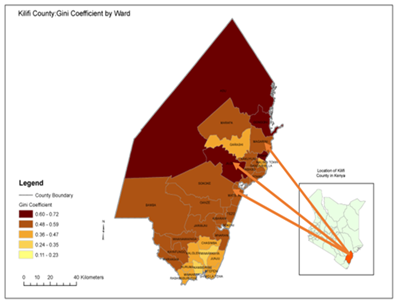
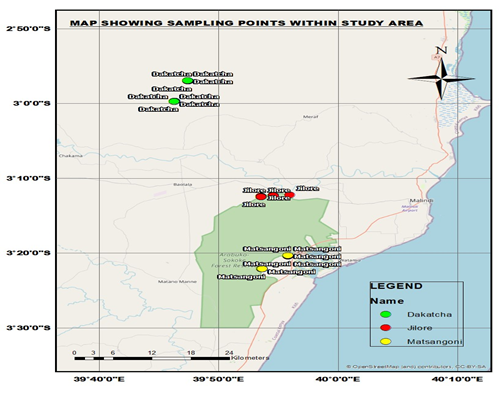
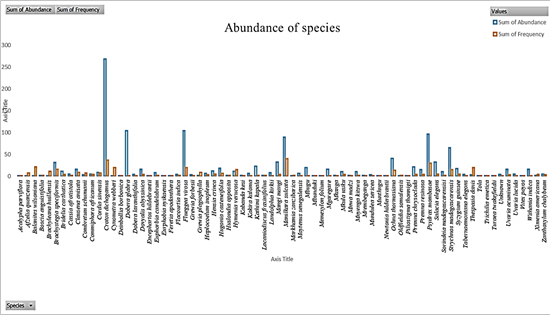
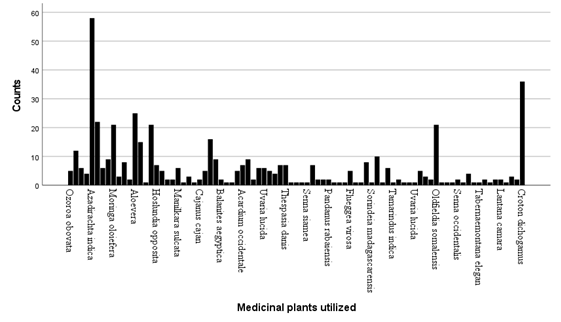
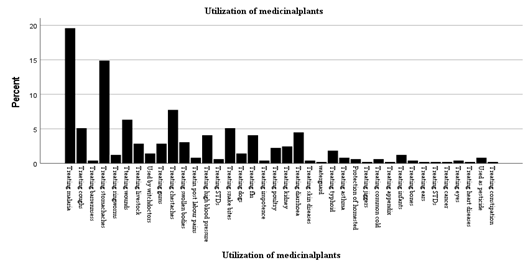
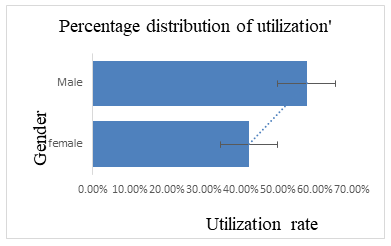
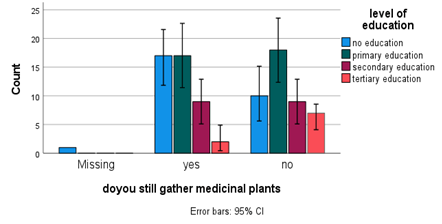
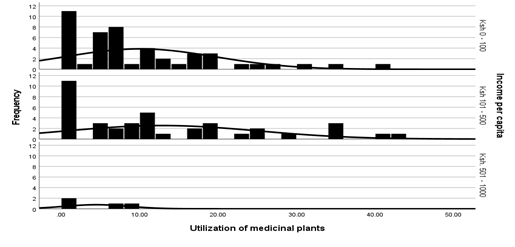
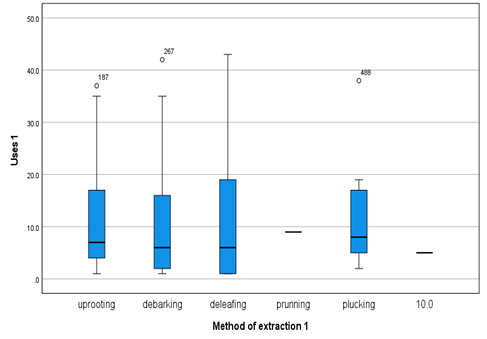
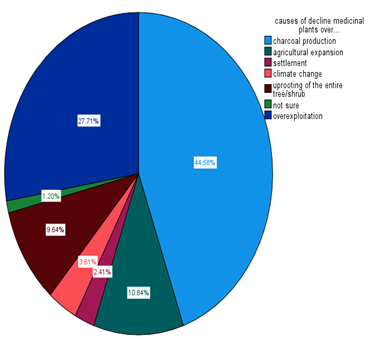
 Impact Factor: * 3.6
Impact Factor: * 3.6 CiteScore: 2.9
CiteScore: 2.9  Acceptance Rate: 11.01%
Acceptance Rate: 11.01%  Time to first decision: 10.4 days
Time to first decision: 10.4 days  Time from article received to acceptance: 2-3 weeks
Time from article received to acceptance: 2-3 weeks 